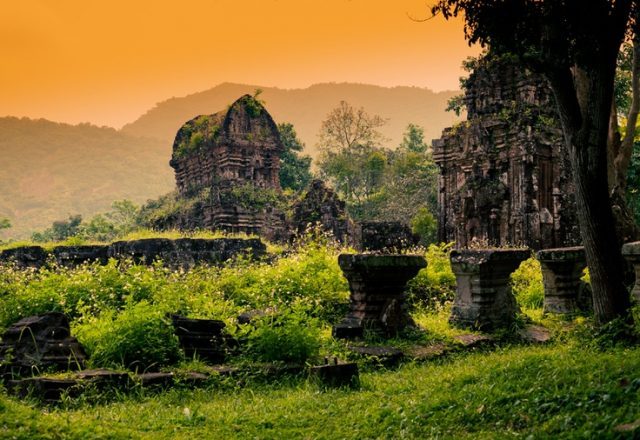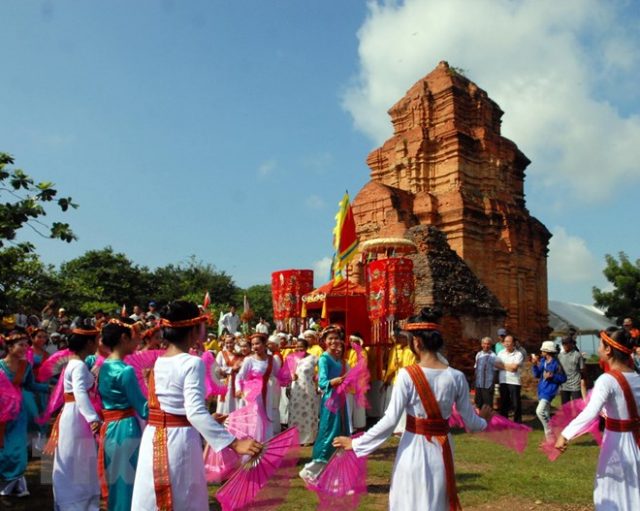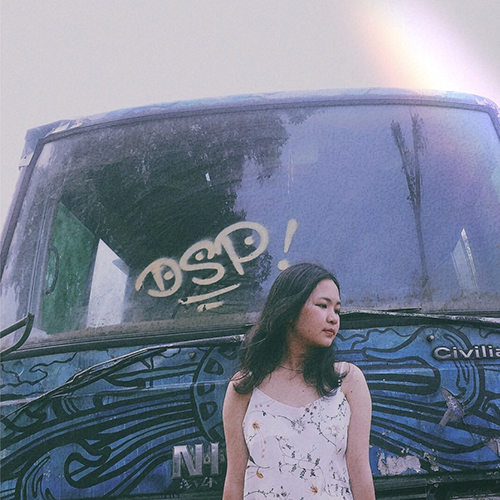My Son Sanctuary used to be a place to worship sacrifices of the Champa dynasty as well as the tombs of the Champa kings or princes. My Son Sanctuary is considered one of the main centers of Hindu temples in Southeast Asia and is the only heritage of its kind in Vietnam, which contains lots of fascinating historical legends and facts that might intrigue you. Let’s find out more about this popular spot with me today!

Where is My Son Sanctuary located?
My Son Sanctuary is located in Duy Phu commune, Duy Xuyen district, Quang Nam province, about 69 kilometers from Da Nang and near the ancient town of Tra Kieu, including many Cham Pa temples, in a valley about 2 kilometers in diameter and is surrounded by majestic hills.
What you should know about its history?
Why was My Son Sanctuary built?
Influenced by the Indian philosophical ideology and the devotion of indigenous beliefs, right from the very beginning of the nation, in order to pray for prosperity for the kingdom and consolidate the kingship, the Champa dynasty built the cathedral worshiping the guardian deity. That is the basic reason when introduced into Champa, the influence of Indian culture is an important basis for the birth of a religious mecca in My Son, including the architectural complex of temples of which Siva is the god be revered and exalted.
But why the first Champa king, Bhadravarman, chose My Son valley as a holy land to build a place to worship the god-king Bhadresvara and not in another place?
It is believed that My Son is located in a closed, craggy valley. This terrain fits well with the requirements of Hinduism. Because Hinduism thinks that the divine space is a sacred space, and that people can attain to God by the way of devotion to the gods. Influenced by Hindu thinking, the Cham also held the idea that being a monk is a pilgrimage, going into a mountainous forest, and the My Son space has met that demand of Brahmanical believers.
The first ever construction and its revolution
Based on other inscriptions, it is known that this site once had the first temple made of wood in the fourth century. More than 2 centuries later, the temple was destroyed in a major fire. In the early seventh century, King Sambhuvarman (reigned from 577 to 629) used bricks to rebuild the temple that still exists today. The later kings continued to remodel the old temples and build new temples to worship the gods.
Brick is a good material to retain the memories of a mysterious people; and the technique of building these towers of the Cams is still a mystery to this day. It has not yet found an appropriate answer about the material of binding, brick burning method and construction.
Although the towers and tombs date from the seventh to the fourteenth centuries, the excavation results show that the Cham kings were buried here in the fourth century. The total number of buildings is over 70.
After the destruction of the kingdom of Champa, My Son Sanctuary was lost in oblivion for centuries, until 1885, it was discovered. Ten years later, researchers began to conduct luminescence, studying the site.
My Son is also the cultural and religious center of the Champa dynasties and the burial place for powerful kings and monks. In addition to that, it was also a place to perform ceremonies and help dynasties reach the gods.

Composition
The overall sanctuary
My Son sanctuary consists of two hills, facing each other in the East – West direction and at the crossroads of a stream, whose branches have become the natural boundary dividing this place into four areas A, B, C, D. This division not only was suitable for spiritual factors but also prevented the tearing of the overall architecture.
The center of the Holy Land is a main tower (Kalan) and many small auxiliary towers surround it. On each arch is a miniature tower, according to the documents, this is the highest tower in the holy towers in My Son with a height of 24 meters. In the tower is a large Linga – Yoni set (now only has a Yoni stone pedestal). The top of the tower has 3 floors, the layers are smaller and the top is sandstone tower. There are fake doors on every floor, with people standing under arches which were decorated with very sophisticated patterns.
A thousand-year-old road in My Son Holy Land
Besides the well-known old towers in My Son Santuary, there lies an ancient road that is worth our attention.
The road was discovered by Indian experts during the excavation and restoration of the K tower in the core of My Son World Cultural Heritage site. Up to 8 meters wide, the road is led by two parallel walls, the depth of which the road is buried nearly 1 meter in the ground and according to recorded documents, this is the first gateway for the kings to enter the central temples and pagoda to sacrifice to the gods and to celebrate the ceremony.
After excavating the experts, it was astonishing at the grandeur of this road with very skillful guide walls, very specific materials such as earthenware and special adhesive additives to build. Thanks to this interesting discovery, it enriched the long-standing historical values, architecture, culture and art created by the ancients in the whole composition.

The old route just revealed at My Son World Cultural Heritage has a starting point at the foot of the K tower, also known as the Gate tower, and the end point can not be determined
Outstanding architectural characteristics of the Sanctuary
This is a complex with more than 70 temple towers with many architectural styles typical of sculpture for each historical period of the Kingdom of Champa. Architectural styles here are divided into 6 types: ancient style, Hoa Lai, Dong Duong, My Son, PoNagar and the style of the people of Binh Dinh. Most of the architectural works and sculptures in My Son are influenced by Hinduism.
The technique of Cham sculpting on bricks rarely appears in other art in other areas. The towers are pyramidal, symbolizing the holy Meru peak, the abode of Hindu gods. The gate of the tower usually turns to the east to receive sunlight. The outer wall of the tower is often decorated with continuous S-shaped leaf patterns. The decorations are Makara sandstone sculpture statues, Apsara dancers, lions, elephants, Garuda birds, and prayers.
The highlight of Cham sculpture is to show the vigor of the human being with the inner mind at the time of both thoughtfulness and anxiety.
It is quite surprising that to this day there has been no research yet to identify binders to tightly stick all the materials together or to stick humanoids and shapes on the tower.

The temple in My Son was built with very durable materials, which still exist today
The effect of time on My Son sanctuary
Through the devastation of war and time, once a magnificent temple complex is now partly only a ruins. Many archaeologists have previously tried to protect the area. For example, in 1937, French scientists restored almost all the temples here. But after the bombardment in 1969, the area of Tower A was almost completely destroyed.
However, most of the small temples in areas B, C and D still exist, although many antiques, large statues and altars were taken away by the French during the war. They have now donated a large number of antiques to the Vietnam Museum of History and the Museum of Cham Sculpture.
One more thing, don’t be surprised when you see Cham artifacts at the famous Louvre museum!
Cultural heritage
My Son Sanctuary not only bears a distinctive architectural style, but it also imbues Cham culture with gentle and impressive Cham dances. Visitors will have the chance to see the Cham dancers often wear candles, water, flowers, and betel nut on their head as a ceremony to celebrate.
In addition, this place also has many unique art activities such as folk performing arts, fire-biting dances, water dance. It will not make visitors disappointed when coming. It is also a destination for photographers who love the mystery, especially in the holy place.
Kate festival
If you come right on the occasion of the festival taking place in My Son Sanctuary, the trip will become much more enjoyable and complete. You will witness the opening of the festival as Cham religious dignitaries perform rituals of prayers at the tower according to the tradition handed down to date. Many other traditional rituals took place such as ceremony, water procession, and Kate rituals.
The festival is an opportunity for indigenous people and tourists to gain more knowledge about the place as well as contribute to maintaining and protecting the pure artistic values of ancient Cham culture.

Kate festival
What to do?
You can try taking a walk around the mecca, feel a spirit of beauty mixed with the grandeur of nature and earth and bring along a camera save the impressive architectural imprints of the ancient people.
Tourists not only experience My Son relics but also should take a visit to a few places that are also well-known in the surrounding area such as Tra Kieu Church, Our Lady of Tra Kieu, Sa Huynh – Champa Cultural Museum.
Why not enjoying delicious and inexpensive specialties here such as Tam Ky chicken rice, Quang Nam green eel porridge, nest cake, Quang noodles with your family and friends. Trust me you might want to come back here a second time because of the food.
The ticket price
Foreigners: 150,000 VND (including entrance fee and service).
Vietnamese: 100,000 VND (including entrance fee and service).
Children under 15 years old will not be charged the fee
How to get there?
Starting the journey to explore the most mysterious place in Vietnam, you can easily get here by any means of motorbike or car. From Hoi An, if traveling by motorbike, i only takes nearly 2 hours to arrive. The rental price for a motorbike is about 150,000 – 200,000 VND / day.
A little note is that you should fill the fuel tank before you go and remember to follow the weather forecast.
Time and war have devastated the monument, but what is left here is still the mysterious beauty, unique architecture with the unique characteristics of the Champa people. It is this that has attracted the curiosity of domestic and foreign tourists coming here to visit and explore. And I think that’s quite enough for you to spend your precious time paying a visit here and discovering what has been left here by the ancestors, isn’t it?
 Alida
Alida
A wanderlust who is into photography and has special interest in chasing clouds and admiring the sky. Hoping that someday I will be able to see the sky from every part of the world.




Comments